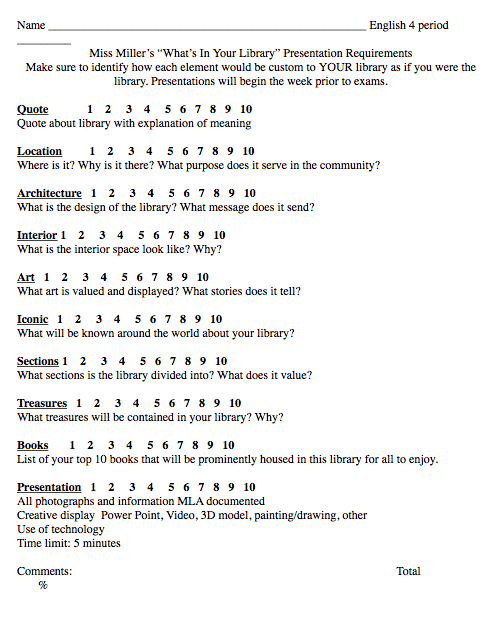Creating the Perfect Library
Developed by Audrey Miller
Alter High School, Centerville
Senior Language Arts
Grade Level: Senior Level English
Introduction
There was a time when libraries were thought to be moving toward obsolescence. Technology is making the need for information gathering as easy as opening a computer and typing a word into Google. Up springs everything you would want to know about a topic and more! Therefore libraries had to reinvent themselves. They had to become more than a place to house and lend books. In fact today there are few traditional books in libraries, but lots of other amenities are contained there. It is not unusual to see cafes, performance spaces, and meeting rooms in local libraries. Audrey Miller, language arts teacher at Alter High School in Kettering, Ohio, visited the New York City Library during the Muse Machine’s Advanced Teacher Training Seminar in 2016. She, like thousands of people before her, was struck by its beauty and awed by its architecture. She was inspired to ask her students to invent their own idea of the perfect library and to align it to their vision of themselves. The resulting outcomes were sometimes radical and often beautiful renditions of what a library can be!

Non-Arts Discipline
English
Strand/Process
Students will communicate, both in person and via technology. Learners present information, concepts, ideas, and viewpoints. Learners demonstrate linguistic and cultural competence through academic endeavors, creative undertakings, and artistic expression.
Content Statement
Enduring Understandings:
Students will gain an appreciation for the library. Students will recognize what society values through its libraries. Students will create a library as a metaphor for themselves and what they value.
Arts Discipline
Content Statement
Progress Points:
- Convey meaning using presentation strategies.
- Organize thoughts and choose resources.
- Produce presentations while keeping audience, context and purpose in mind.
- Revise and edit texts/presentations using tools that promote reflection on meaning, form, and mechanics.
- Rehearse presentations using a range of delivery strategies.
- Use appropriate techniques to cite sources and avoid plagiarism
Essential Questions
- How are society’s values for education reflected by its library?
- How do the components of a student’s personal library reflect who he/she is?
- What do we value in society and the arts?
- Who are you?
- What do you value from society and the arts?
Content Elaborations
Students will learn …
the importance of libraries and the opportunities that exist within them.
Expectations for Learning
Students will demonstrate this learning by…
designing their own library that is a metaphor for themselves.
Instructional Strategies
Students will be engaged and supported in learning by…
power point of examples.
Assessment (Pre and/or Post)
Pre-test Kahoot testing their comfortability with library information and key terms.
Post assessment – utilizing all the required elements in their presentation.
Materials & Resources
Materials list for Teachers:
- A Kahoot or other survey tool
- What’s in Your Library-PowerPoint presentation
- Projector
- Computer
Materials list for Students:
- Computer
- Internet connection
- Imagination
Key Vocabulary
Architectural terms:
- Modern
- Post Modern
- Classical
Student Performance Tasks
After watching and discussing the information on the What’s In Your Library PowerPoint, students will design a library that best represents them. They will then present this information to the class. They may build a 3D model or create a technological representation through any presentation tool.
Career Connections
- Technology
- Library Sciences
- Art appreciation
- Business-presentation
Diverse Learners
Students will work at their own pace. Students will be offered technical help. Students will be given the ability to verbally present their creations.
Interdisciplinary Connections
A visit to the New York City Library during ATTS 2016 inspired this lesson and prompted me to ask, “What will libraries of the future be like?” They designed their own and presented it to the class. Students could use math to find the square footage of their library. Students could incorporate pop culture or history to portray significant sculptures or paintings that depict historical events. Students could incorporate art and famous painters as décor for their library. Students could incorporate theological references to relics that might be housed in their library. Students could incorporate foreign languages in the naming of rooms or divisions of their library. Student can utilize technology in the design and presentation of their final product. This is a direct connection to the time I spent exploring the New York City Public Library as both a monument to what society values in the arts and education.
Technology Connections
Technology is the driving force behind this project and is incorporated at all stages of the presentation and research.
Home/At Work Connections
Students will create their own technologically based presentation that explains their library creation.